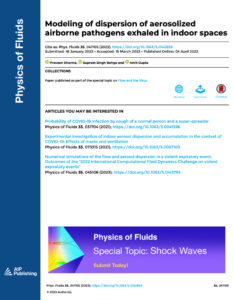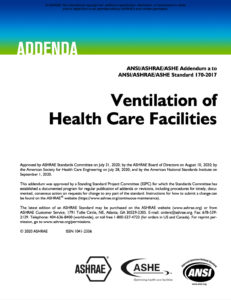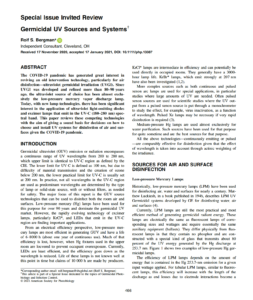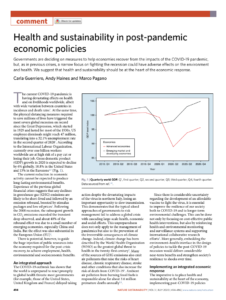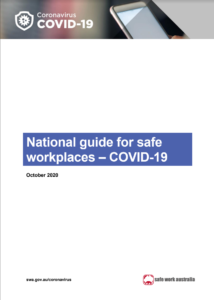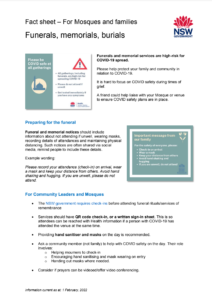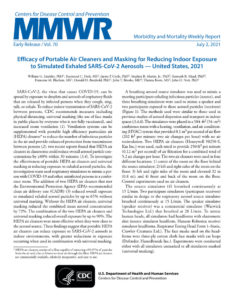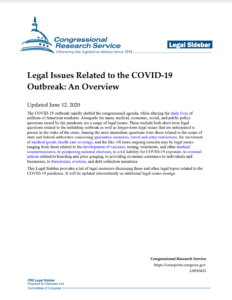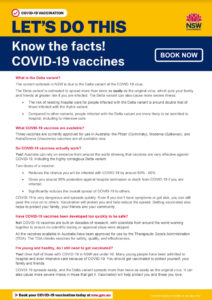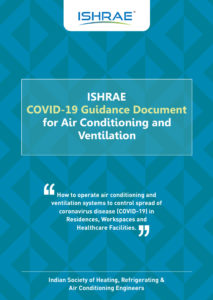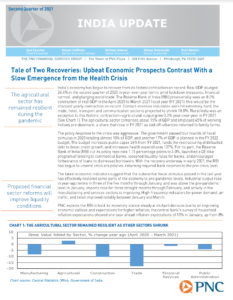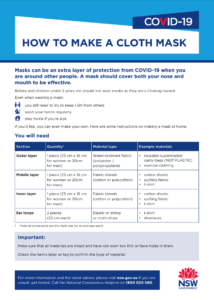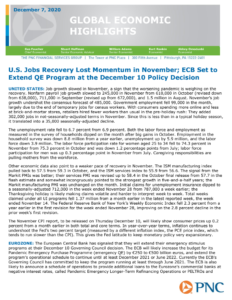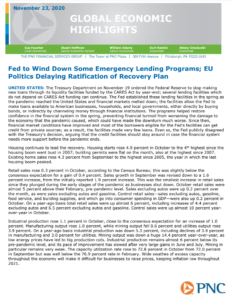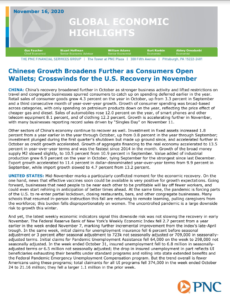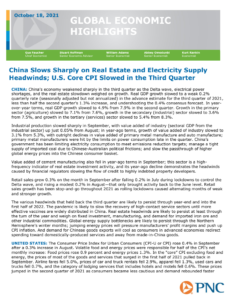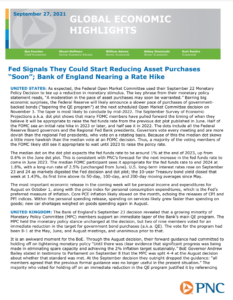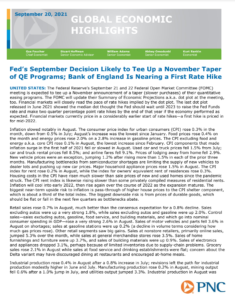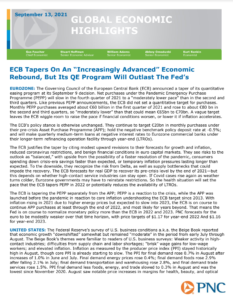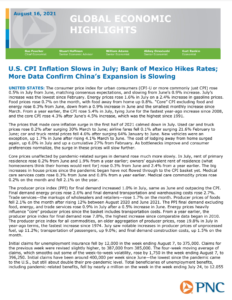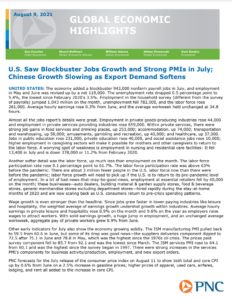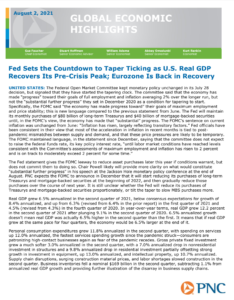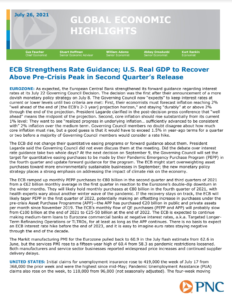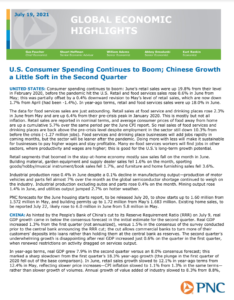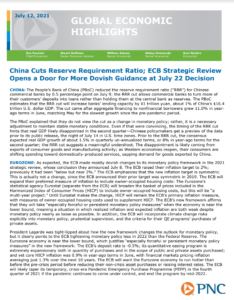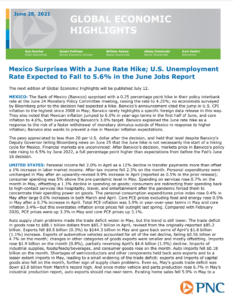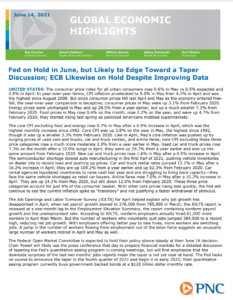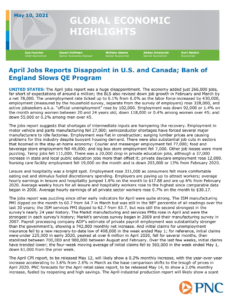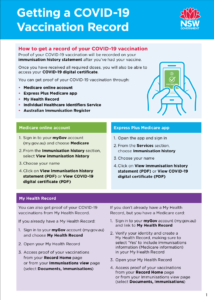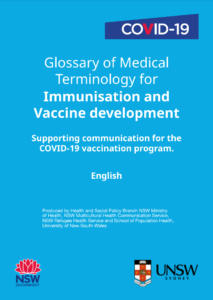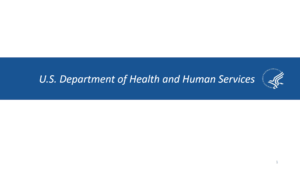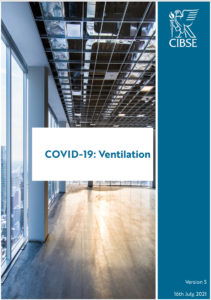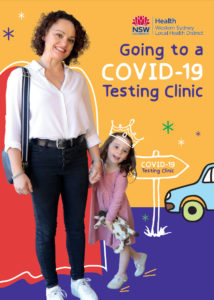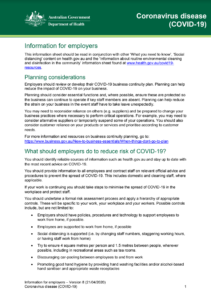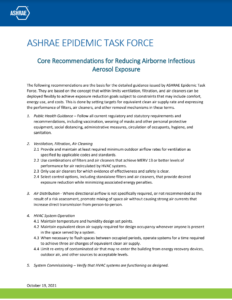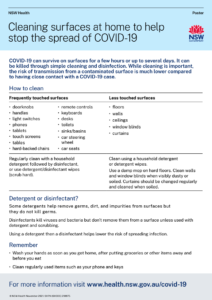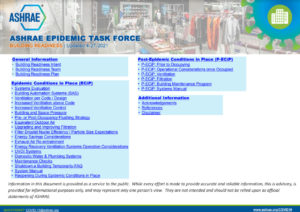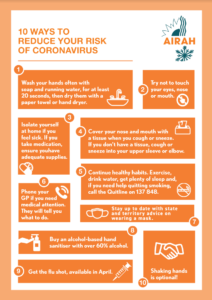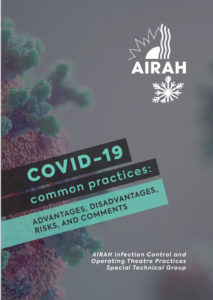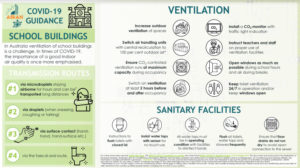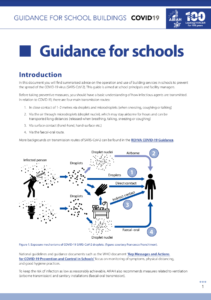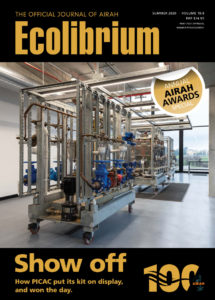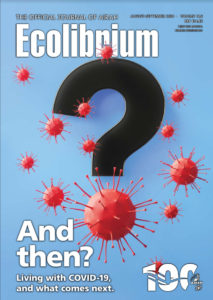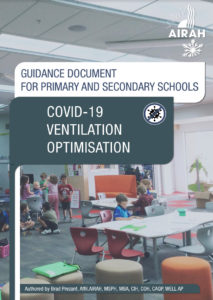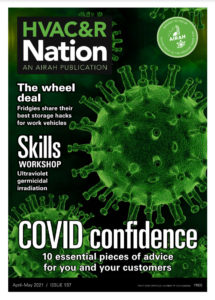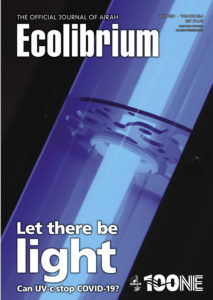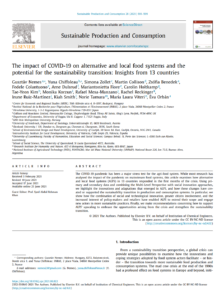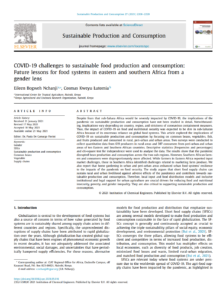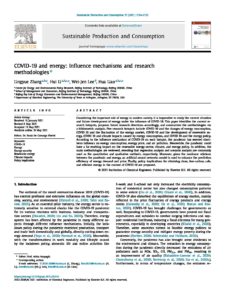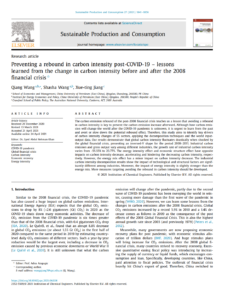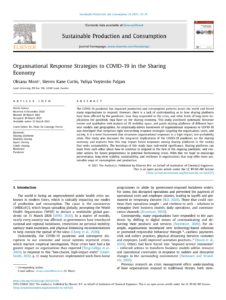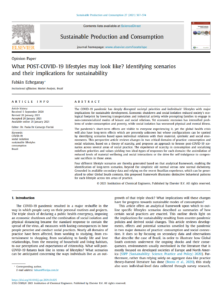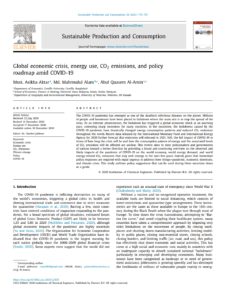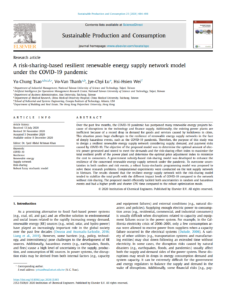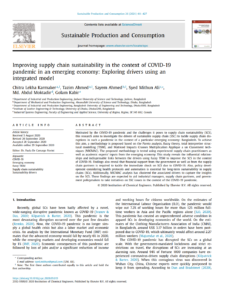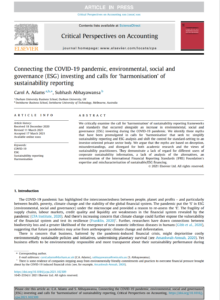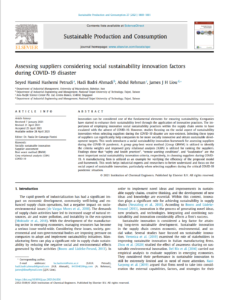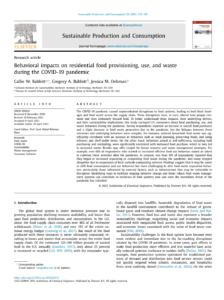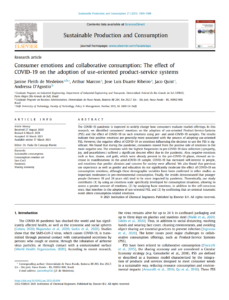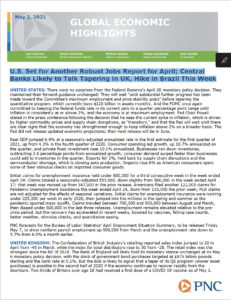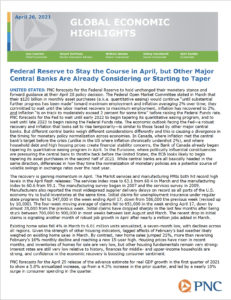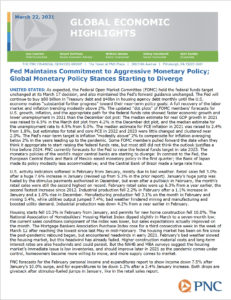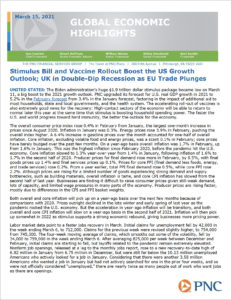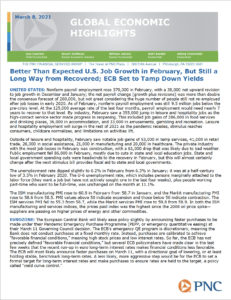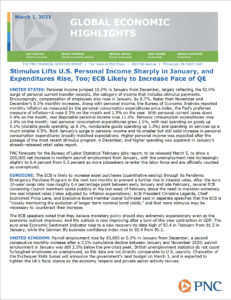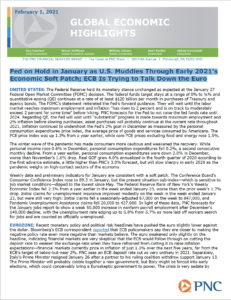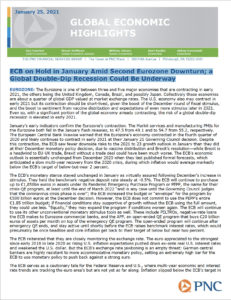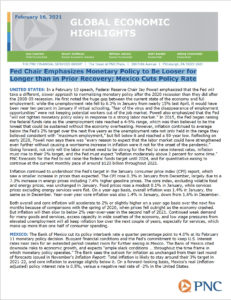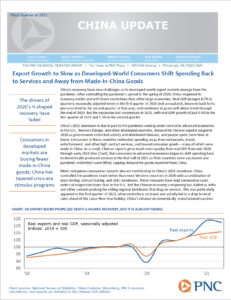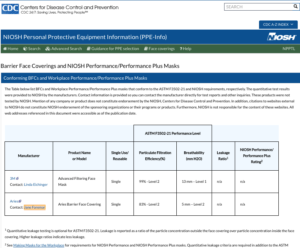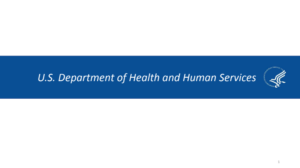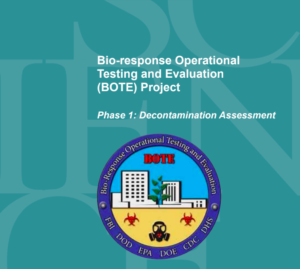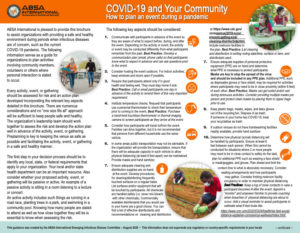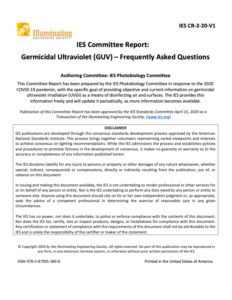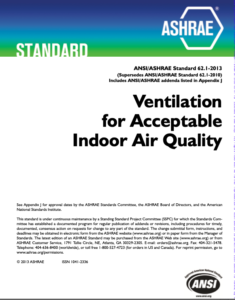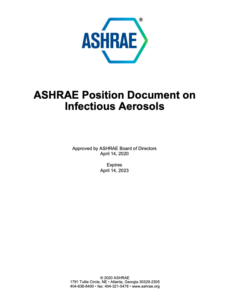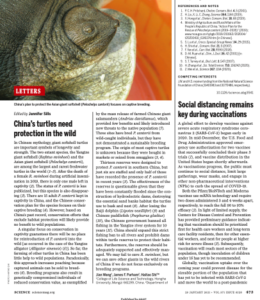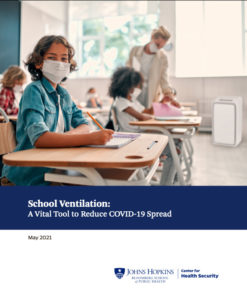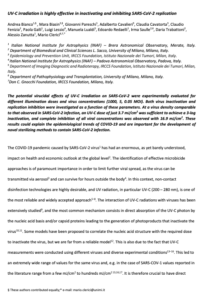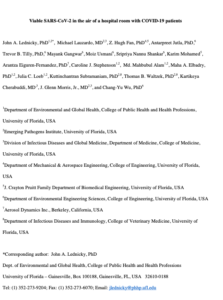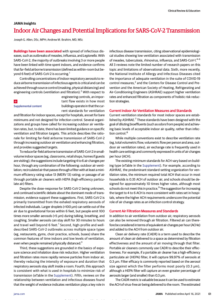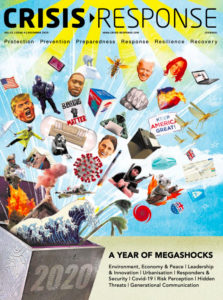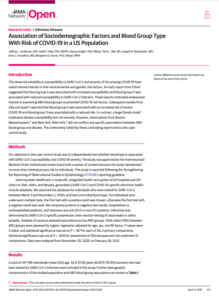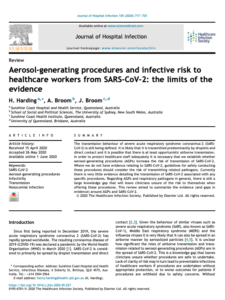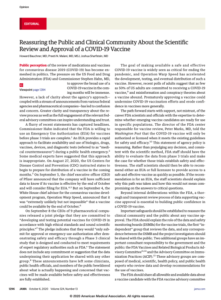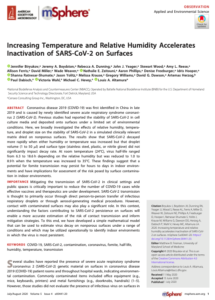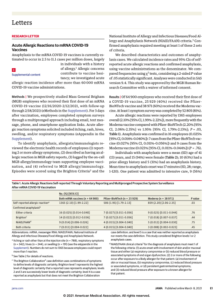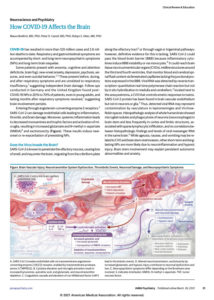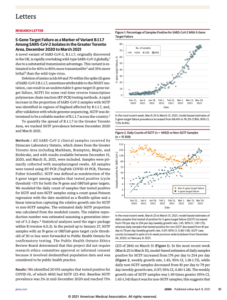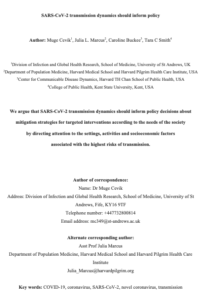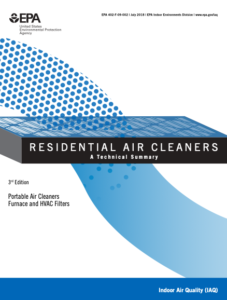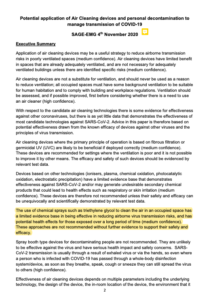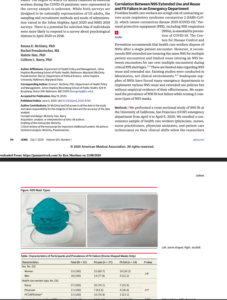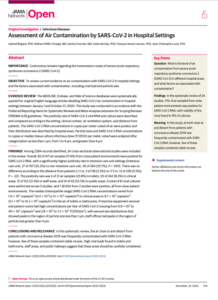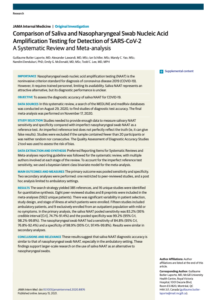[searchandfilter id="1060"]
Modeling of dispersion of aerosolized airborne pathogens exhaled in indoor spaces
Since the beginning of the COVID-19 pandemic, there has been a lack of data to quantify the role played by breathing-out of pathogens in the spread of SARS-Cov-2 despite sufficient indication of its culpability. This work aims to establish the role of aerosol dispersion of SARS- Cov-2 virus and similar airborne pathogens on the spread […]
Ventilation of Health Care Facilities
ANSI/ASHRAE/ASHE Addendum a to ANSI/ASHRAE/ASHE Standard 170-2017 Addendum a clarifies filtration requirements on a space-by-space basis. The filtration levels designated and their rational basis, are included in Informative Appendix C, Table C-1. In brief, this addendum.
COVID-19 Exposure Assessment Tool (CEAT): Exposure quantification based on ventilation, infection prevalence, group characteristics, and behavior
The coronavirus disease 2019 (COVID-19) Exposure Assessment Tool (CEAT) allows users to compare respiratory relative risk to severe acute respiratory syndrome coronavirus 2 (SARS-CoV-2) for various scenarios, providing understanding of how combinations of protective measures affect risk. CEAT incorporates mechanistic, stochastic, and epidemiological factors including the (i) emission rate of virus, (ii) viral aerosol degradation […]
Germicidal UV Sources and Systems
The COVID-19 pandemic has generated great interest in reviving an old intervention technology, particularly for air disinfection—ultraviolet germicidal irradiation (UVGI). Since UVGI was developed and refined more than 80–90 years ago, the ultraviolet source of choice has been almost exclusively the low-pressure mercury vapor discharge lamp. Today, with new lamp technologies, there has been significant […]
Efficacy of universal masking for source control and personal protection from simulated cough and exhaled aerosols in a room
Face masks reduce the expulsion of respiratory aerosols produced during coughs and exhalations (“source control”). Factors such as the directions in which people are facing (orientation) and separation distance also affect aerosol dispersion. However, it is not clear how the combined effects of masking, orientation, and distance affect the exposure of individuals to respiratory aerosols […]
Health and sustainability in post-pandemic economic policies
Governments are deciding on measures to help economies recover from the impacts of the COVID-19 pandemic, but, as in previous crises, a narrow focus on fighting the recession could have adverse effects on the environment and health. We suggest that health and sustainability should be at the heart of the economic response.
National Guide for Safe Workplaces: COVID-19
The COVID-19 pandemic has had an unprecedented impact on the way people live and work. Australian workplaces of all sizes and across all industries have had to significantly modify their operations to protect their workers and the broader community. Until there is an effective vaccine or treatment, there can be no return to business as […]
Fact Sheet for Mosques and Families: Funerals, Memorials, and Burials
Funerals and memorial services are high-risk for COVID-19 spread. Please help protect your family and community in relation to COVID-19. It is hard to focus on COVID safety during times of grief. A friend could help liaise with your Mosque or venue to ensure COVID safety plans are in place.
Legal Issues Related to the COVID-19 Outbreak: An Overview
Updated June 12, 2020 The COVID-19 outbreak rapidly shifted the congressional agenda, while altering the daily lives of millions of American residents. Alongside the many medical, economic, social, and public policy questions raised by the pandemic are a range of legal issues. These include both short-term legal questions related to the unfolding outbreak as well […]
ISHRAE COVID-19 Guidance Document for Air Conditioning and Ventilation
How to operate air conditioning and ventilation systems to control spread of coronavirus disease (COVID-19) in Residences, Workspaces and Healthcare Facilities.
Tale of Two Recoveries: Upbeat Economic Prospects Contrast With a Slow Emergence from the Health Crisis
The agricultural sector has remained resilient during the pandemic.
How to Make a Cloth Mask
Masks can be an extra layer of protection from COVID-19 when you are around other people. A mask should cover both your nose and mouth to be effective.
U.S. Jobs Recovery Lost Momentum in November; ECB Set to Extend QE Program at the December 10 Policy Decision
Job growth slowed in November, a sign that the worsening pandemic is weighing on the recovery. Nonfarm payroll job growth slowed to 245,000 in November from 610,000 in October (revised down from 638,000), 711,000 in September (revised up from 672,000), and 1.5 million in August. November’s job growth undershot the consensus forecast of 485,000. Government […]
Fed to Wind Down Some Emergency Lending Programs; EU Politics Delaying Ratification of Recovery Plan
The Treasury Department on November 19 ordered the Federal Reserve to stop making new loans through its liquidity facilities funded by the CARES Act by year-end; several lending facilities which do not depend on CARES Act funding can continue. The Fed established these lending facilities in the spring as the pandemic reached the United States […]
Chinese Growth Broadens Further as Consumers Open Wallets; Crosswinds for the U.S. Recovery in November
China’s recovery broadened further in October as stronger business activity and lifted restrictions on travel and congregate businesses spurred consumers to catch up on spending deferred earlier in the year. Retail sales of consumer goods grew 4.3 percent on the year in October, up from 3.3 percent in September and a third consecutive month of […]
China Slows Sharply on Real Estate on Electricity Supply Headwinds; U.S. Core CPI Slowed in the Third Quarter
China’s economy weakened sharply in the third quarter as the Delta wave, electrical power shortages, and the real estate slowdown weighed on growth. Real GDP growth slowed to a weak 0.2% quarterly rate (seasonally adjusted but not annualized) in the advance estimate for the third quarter of 2021, less than half the second quarter’s 1.3% […]
Fed Signals They Could Start Reducing Asset Purchases “Soon”; Bank of England Nearing a Rate Hike
As expected, the Federal Open Market Committee used their September 22 Monetary Policy Decision to tee up a reduction in monetary stimulus. The key phrase from their monetary policy statement reads, “A moderation in the pace of asset purchases may soon be warranted.” Barring big economic surprises, the Federal Reserve will likely announce a slower […]
Fed’s September Decision Likely to Tee Up a November Taper of QE Programs; Bank of England Is Nearing a First Rate Hike
The Federal Reserve’s September 21 and 22 Federal Open Market Committee (FOMC) meeting is expected to tee up a November announcement of a taper (slower purchases) of their quantitative easing programs. The FOMC will update their Summary of Economic Projections a.k.a. dot plot at the meeting, too. Financial markets will closely read the pace of […]
ECB Tapers On An “Increasingly Advanced” Economic Rebound, But Its QE Program Will Outlast the Fed’s
The Governing Council of the European Central Bank (ECB) announced a taper of its quantitative easing program at its September 9 decision. Net purchases under the Pandemic Emergency Purchase Programme (PEPP) will slow in the fourth quarter of 2021 to a “moderately lower pace” than in the second and third quarters. Like previous PEPP announcements, […]
U.S. CPI Inflation Slows in July; Bank of Mexico Hikes Rates; More Data Confirm China’s Expansion is Slowing
The consumer price index for urban consumers (CPI-U or more commonly just CPI) rose 0.5% in July from June, matching consensus expectations, and slowing from June’s 0.9% increase. July’s increase was the lowest since February. Energy prices rose 1.6% in July on a 2.4% increase in gasoline prices. Food prices rose 0.7% on the month, […]
U.S. Saw Blockbuster Jobs Growth and Strong PMIs in July; Chinese Growth
The economy added a blockbuster 943,000 nonfarm payroll jobs in July, and employment in May and June was revised up by a net 119,000. The unemployment rate dropped 0.5 percentage point to 5.4%, the lowest since February 2020’s 3.5%. Employment in the household survey (different from the survey of payrolls) jumped 1.043 million on the […]
Fed Sets the Countdown to Taper Ticking as U.S. Real GDP Recovers Its Pre-Crisis Peak; Eurozone Is Back in Recovery
The Federal Open Market Committee kept monetary policy unchanged in its July 28 decision, but signaled that they have started the tapering clock. The committee said that the economy has made “progress” toward their goals of full employment and inflation averaging 2% over the longer run, but not the “substantial further progress” they set in […]
ECB Strengthens Rate Guidance; U.S. Real GDP to Recover Above Pre-Crisis Peak in Second Quarter’s Release
As expected, the European Central Bank strengthened its forward guidance regarding interest rates at its July 22 Governing Council Decision. The decision was the first after their announcement of a more dovish monetary policy strategy on July 8. The Governing Council now “expects” to keep interest rates at current or lower levels until two criteria […]
U.S. Consumer Spending Continues to Boom; Chinese Growth a Little Soft in the Second Quarter
Consumer spending continues to boom: June’s retail sales were up 19.8% from their level in February 2020, before the pandemic hit the U.S. Retail and food services sales rose 0.6% in June from May; this was partially offset by a 0.4% downward revision to May’s level of retail sales, which are now down 1.7% from […]
China Cuts Reserve Requirement Ratio; ECB Strategic Review Opens a Door for More Dovish Guidance at July 22 Decision
The People’s Bank of China (PBoC) reduced the reserve requirement ratio (“RRR”) for Chinese commercial banks by 0.5 percentage point on July 9; the RRR cut allows commercial banks to turn more of their customers’ deposits into loans rather than holding them at the central bank as reserves. The PBoC estimates that the RRR cut […]
Mexico Surprises With a June Rate Hike; U.S. Unemployment Rate Expected to Fall to 5.6% in the June Jobs Report
The Bank of Mexico (Banxico) surprised with a 0.25 percentage point hike in their policy interbank rate at the June 24 Monetary Policy Committee meeting, raising the rate to 4.25%; no economists surveyed by Bloomberg prior to the decision had expected a hike. Banxico’s announcement cited the jump in U.S. CPI inflation to the highest […]
Fed on Hold in June, but Likely to Edge Toward a Taper Discussion; ECB Likewise on Hold Despite Improving Data
The consumer price index for all urban consumers rose 0.6% in May vs 0.5% expected and 0.8% in April. In year-over-year terms, CPI inflation accelerated to 5.0% in May from 4.2% in April and was the highest since August 2008. But since consumer prices fell last April and May as the economy entered free-fall, the […]
April Jobs Reports Disappoints in U.S. and Canada; Bank of England Slows QE Program
The April jobs report was a huge disappointment. The economy added just 266,000 jobs, far short of expectations of around a million; the BLS also revised down job growth in February and March by a net 78,000. The unemployment rate ticked up to 6.1% from 6.0% as the labor force increased by 430,000, employment (measured […]
Glossary of Medical Terminology for Immunisation and Vaccine Development
This glossary was developed to help community organisations, translators and interpreters, bilingual workers, and community leaders to better understand and communicate about vaccine development and implementation.
COVID-19: Ventilation
The evidence continues to suggest that in poorly ventilated indoor spaces, airborne aerosols are a possible transmission route of SARS-CoV-2, and the precautionary advice remains valid. Maintaining good levels of ventilation remains the key focus, even in colder weather conditions, whilst minimising occupant discomfort due to draughts and lower indoor temperatures. The risk of exposure […]
Going to a COVID-19 Testing Clinic
This booklet was developed by Centre for Population Health, Western Sydney Local Health District.
COVID-19 Information for Employers
This information sheet should be read in conjunction with other ‘What you need to know’, ‘Social distancing’ content on health.gov.au and the ‘information about routine environmental cleaning and disinfection in the community’ information sheet found at www.health.gov.au/covid19-resources.
Core Recommendations for Reducing Airborne Infectious Aerosol Exposure
The following recommendations are the basis for the detailed guidance issued by ASHRAE Epidemic Task Force. They are based on the concept that within limits ventilation, filtration, and air cleaners can be deployed flexibly to achieve exposure reduction goals subject to constraints that may include comfort, energy use, and costs. This is done by setting […]
Cleaning surfaces at home to help stop the spread of COVID-19
COVID-19 can survive on surfaces for a few hours or up to several days. It can be killed through simple cleaning and disinfection. While cleaning is important, the risk of transmission from a contaminated surface is much lower compared to having close contact with a COVID-19 case.
ASHRAE Epidemic Task Force Building Readiness
The following Building Readiness information is meant to provide practical information and checklists for how your building should be operating and how to practically check its operation. Actual conditions at any specific building will vary, and the adjustments that should be made will depend on many factors such as local climate, complexity of systems involved […]
COVID-19 Guidance: School Buildings
In Australia ventilation of school buildings is a challenge. In times of COVID-19, the importance of a good indoor air quality is once more emphasised.
Guidance for School Buildings – COVID-19
In this document you will find summarised advice on the operation and use of building services in schools to prevent the spread of the COVID-19 virus (SARS-CoV-2). This guide is aimed at school principals and facility managers.
Different Wavelengths
Can ultraviolet light help limit the spread of COVID-19? Ecolibrium assembled a panel with diverse opinions to discuss UV-c technology in HVAC systems.
And then? Living with COVID-19, and what comes next.
The onset of the COVID-19 pandemic has turned life as we knew it upside-down, both around the world and here in Australia. Although much of our nation has avoided the tragic health crisis we’ve seen unfold overseas, we face a new kind of normal in the weeks, months and possibly years ahead. Sean McGowan reports.
Guidance Document for Primary and Secondary Schools: COVID-19 Ventilation Optimisation
Schools are re-opening throughout Australia. School administrators and teachers are concerned about the safety of children and staff. There are many more questions about the best way to protect children from COVID-19 infection at school than there are answers. School administrators are being bombarded by vendors selling a myriad of products, some of which may […]
COVID Confidence: 10 Essential Pieces of Advice for You and Your Customers
Since our world got turned upside down, we’ve been learning more and more about COVID-19 and how to prevent its spread. Although we’re still a long way from understanding the virus completely, the time seemed right to provide an update. Drawing from AIRAH’s extensive COVID-19 guidance and external resources, we’ve compiled a list of 10 […]
Let there be light: Can UV-c stop COVID-19?
Can ultraviolet light help limit the spread of COVID-19? Ecolibrium assembled a panel with diverse opinions to discuss UV-c technology in HVAC systems.
The impact of COVID-19 on alternative and local food systems and the potential for the sustainability transition: Insights from 13 countries
The COVID-19 pandemic has been a major stress test for the agri-food system. While most research has analysed the impact of the pandemic on mainstream food systems, this article examines how alternative and local food systems (ALFS) in 13 countries responded in the first months of the crisis. Using primary and secondary data and combining […]
COVID-19 challenges to sustainable food production and consumption: Future lessons for food systems in eastern and southern Africa from a gender lens
Despite fears that sub-Sahara Africa would be severely impacted by COVID-19, the implications of the pandemic on sustainable production and consumption have not been studied in detail. Notwithstanding, implications vary depending on country, region, and strictness of coronavirus containment measures. Thus, the impact of COVID-19 on food and nutritional security was expected to be dire […]
COVID-19 and energy: Influence mechanisms and research methodologies
Considering the important role of energy in modern society, it is imperative to study the current situation and future development of energy under the influence of COVID-19. This paper identifies the current research hotspots, proposes future research directions accordingly, and summarizes the methodologies via a bibliometric analysis. Five research hotspots include COVID-19 and the changes […]
Preventing a rebound in carbon intensity post-COVID-19 – lessons learned from the change in carbon intensity before and after the 2008 crisis
The carbon emission rebound of the post-2008 financial crisis teaches us a lesson that avoiding a rebound in carbon intensity is key to prevent the carbon emission increase afterward. Although how carbon emission will change the world after the COVID-19 pandemic is unknown, it is urgent to learn from the past and avert or slow […]
Organisational Response Strategies to COVID-19 in the Sharing Economy
The COVID-19 pandemic has impacted production and consumption patterns across the world and forced many organisations to respond. However, there is a lack of understanding as to how sharing platforms have been affected by the pandemic, how they responded to the crisis, and what kinds of long-term implications the pandemic may have on the sharing […]
Global economic crisis, energy use, CO2 emissions, and policy roadmap amid COVID-19
The COVID-19 pandemic has emerged as one of the deadliest infectious diseases on the planet. Millions of people and businesses have been placed in lockdown where the main aim is to stop the spread of the virus. As an extreme phenomenon, the lockdown has triggered a global economic shock at an alarming pace, conveying sharp […]
A risk-sharing-based resilient renewable energy supply network model under the COVID-19 pandemic
Over the past few months, the COVID-19 pandemic has postponed many renewable energy projects because of disruptions in the technology and finance supply. Additionally, the existing power plants are inefficient because of a record drop in demand for goods and services caused by lockdowns in cities. This situation poses huge challenges to the resilience of […]
Improving supply chain sustainability in the context of COVID-19 pandemic in an emerging economy: Exploring drivers using an integrated model
Motivated by the COVID-19 pandemic and the challenges it poses to supply chain sustainability (SCS), this research aims to investigate the drivers of sustainable supply chain (SSC) to tackle supply chain disruptions in such a pandemic in the context of a particular emerging economy: Bangladesh. To achieve this aim, a methodology is proposed based on […]
Connecting the COVID-19 pandemic, environmental, social and governance (ESG) investing and calls for ‘harmonisation’ of sustainability reporting
We critically examine the call for ‘harmonisation’ of sustainability reporting frameworks and standards that occurred alongside an increase in environmental, social and governance (ESG) investing during the COVID-19 pandemic. We identify three myths that have been promulgated in calls for ‘harmonisation’ that seek to: simplify sustainability reporting and ESG analysis and shift the control for […]
Behavioral impacts on residential food provisioning, use, and waste during the COVID-19 pandemic
The COVID-19 pandemic caused unprecedented disruptions to food systems, leading to both food shortages and food waste across the supply chain. These disruptions have, in turn, altered how people consume and then ultimately discard food. To better understand these impacts, their underlying drivers, and their sustainability implications, this study surveyed U.S. consumers about food purchasing, […]
Consumer emotions and collaborative consumption: The effect of COVID-19 on the adoption of use-oriented product-service systems
The COVID-19 pandemic is expected to widely change how consumers evaluate market offerings. In this research, we identified consumers’ emotions on the adoption of use-oriented Product-Service-Systems (PSS) and the effect of COVID-19 on such emotions using pre- and amid-COVID-19 samples. The results indicate that positive emotions are generally more associated with the process of adopting […]
Global Economic Highlights: U.S. Set for Another Robust Jobs Report for April; Central Banks Likely to Talk Tapering in UK, Hike in Brazil This Week
The PNC Financial Services Group’s May 2, 2021 Economic Report
Global Economic Highlights: Federal Reserve to Stay the Course in April, but Other Major Central Banks Are Already Considering or Starting to Taper
The PNC Financial Services Group’s April 26, 2021 Economic Report
Global Economic Highlights: Fed Maintains Commitment to Aggressive Monetary Policy; Global Monetary Policy Stances Starting to Diverge
The PNC Financial Services Group’s March 22, 2021 Economic Report
Global Economic Highlights: Stimulus Bill and Vaccine Rollout Boost the US Growth Outlook; UK in Double-Dip Recession as EU Trade Plunges
The PNC Financial Services Group’s March 15, 2021 Economic Report
Global Economic Highlights: Better Than Expected U.S. Job Growth in February, But Still a Long Way from Recovered; ECB Set to Tamp Down Yields
The PNC Financial Services Group’s March 8, 2021 Economic Report
Global Economic Highlights: Stimulus Lifts U.S. Personal Income Sharply in January, and Expenditures Rise, Too; ECB Likely to Increase Pace of QE
The PNC Financial Services Group’s March 1, 2021 Economic Report
Global Economic Highlights: Fed on Hold in January as U.S. Muddles Through Early 2021’s Economic Soft Patch; ECB Is Trying to Talk Down the Euro
The PNC Financial Services Group’s February 1, 2021 Economic Report
Global Economic Highlights: ECB on Hold in January Amid Second Eurozone Downturn; a Global Double-Dip Recession Could Be Underway
The PNC Financial Services Group’s January 25, 2021 Economic Report
Global Economic Highlights: Brexit Uncertainty Resolves, but UK-EU Trade Tensions to Persist; US Jobless Claims Edged Lower in Late December
The PNC Financial Services Group’s January 4, 2021 Economic Report
Global Economic Highlights: Fed Chair Emphasizes Monetary Policy to Be Looser for Longer than in Prior Recovery; Mexico Cuts Policy Rate
The PNC Financial Services Group’s February 16, 2021 Economic Report
Export Growth to Slow as Developed-World Consumers Shift Spending Back to Services and Away from Made-In-China Goods
China’s economy faces new challenges as its developed-world export markets emerge from the pandemic. After controlling the pandemic’s spread in the spring of 2020, China reopened its economy earlier and with fewer restrictions than other large economies. Real GDP plunged 8.7% in quarterly seasonally-adjusted terms in the first quarter of 2020 (not annualized), bounced back […]
NIOSH Personal Protective Equipment Information (PPE-Info)
Barrier Face Coverings and NIOSH Performance/Performance Plus Masks Conforming BFCs and Workplace Performance/Performance Plus Masks The Table below list BFCs and Workplace Performance/Performance Plus masks that conform to the ASTM F3502-21 and NIOSH requirements, respectively. The quantitative test results were provided to NIOSH by the manufacturers. Contact information is provided so you can contact the […]
U.S. Department of Health and Human Services
This fact sheet summarizes best practices for national implementation to sustain supplies of personal protective equipment (PPE) while ensuring the protection of healthcare personnel (HCP) and first responders during the coronavirus (COVID-19) pandemic response.
Bio-response Operational Testing and Evaluation (BOTE) Project
Following the tragic events of September 11, 2001, new legislation, Presidential Directives, and national plans called upon the U.S. Environmental Protection Agency (EPA) to support government-wide efforts to prevent, protect, mitigate, respond to, and recover from terrorist attacks, natural disasters, catastrophic incidents, and other hazards. Although these homeland security responsibilities can be traced to EPA’s traditional role in consequence […]
COVID-19 and Your Community How to plan an event during a pandemic
Every activity, event, or gathering should be assessed for risk and an action plan developed incorporating the relevant key aspects detailed in this brochure. There are numerous considerations and no “one size fits all” approach will be sufficient to keep people safe and healthy. The organization’s leadership team should work together to assess the risk and develop […]
IES Committee Report: Germicidal Ultraviolet (GUV) – Frequently Asked Questions
The 2014 outbreak of the Ebola virus and the recent spread of the novel coronavirus disease 2019 (COVID-19) have renewed interest in germicidal ultraviolet (GUV) lamps for disinfection. UV radiant energy was first used for disinfecting surfaces in 1877,1,2 for water in 1910,3 and for air in 1935.4 GUV’s use in recent decades has been […]
ENHANCED INDUSTRY-WIDE HOTEL CLEANING STANDARDS in response to COVID-19.
Hospitality at its core is an industry of people taking care of people. The safety of our guests and employees has always been our number one priority. Now as we work to reopen our nation’s economy, we want to ensure travelers that hotels will be cleaner and safer than ever before when they are ready […]
Ventilation for Acceptable Indoor Air Quality
The purpose of this standard is to specify minimum ventilation rates and other measures intended to provide indoor air quality that is acceptable to human occupants and that minimizes adverse health effects. This standard is intended for regulatory application to new buildings, additions to existing buildings, and those changes to existing buildings that are identified […]
ASHRAE Position Document on Infectious Aerosols
With infectious diseases transmitted through aerosols, HVAC systems can have a major effect on the transmission from the primary host to secondary hosts. Decreasing exposure of secondary hosts is an important step in curtailing the spread of infectious diseases. Designers of mechanical systems should be aware that ventilation is not capable of addressing all aspects […]
School Ventilation: A Vital Tool to Reduce COVID-19 Spread
Many kindergarten through 12th grade (K-12) schools in the United States do not have good ventilation. This is a longstanding problem with demonstrably negative effects on student learning. We can and should act to fix this to ensure good indoor air quality for all students, educators, and school staff. During the COVID-19 pandemic, it is […]
UV-C irradiation is highly effective in inactivating and inhibiting SARS-CoV-2 replication
The COVID-19 pandemic caused by SARS-CoV-2 virus has had an enormous, as yet barely understood, impact on health and economic outlook at the global level. The identification of effective microbicide approaches is of paramount importance in order to limit further viral spread, as the virus can be transmitted via aerosol and can survive for hours […]
Viable SARS-CoV-2 in the air of a hospital room with COVID-19 patients
Severe acute respiratory syndrome coronavirus 2 (SARS-CoV-2), genus Betacoronavirus, subgenus Sarbecovirus, family Coronaviridae, is a positive-polarity single-stranded RNA virus that probably originated in bats and is the causative agent of coronavirus disease of 2019 (COVID-19). The dynamics of the COVID-19 pandemic have proven to be complex. Many challenges remain pertaining to a better understanding of […]
Indoor Air Changes and Potential Implications for SARS-CoV-2 Transmission
Buildings have been associated with spread of infectious diseases, such as outbreaks of measles, influenza, and Legionella. With SARS-CoV-2, the majority of outbreaks involving 3 or more people have been linked with time spent indoors, and evidence confirms that far-field airborne transmission (defined as within-room but beyond 6 feet) of SARS-CoV-2 is occurring. Controlling concentrations […]
Association of Sociodemographic Factors and Blood Group Type With Risk of COVID-19 in a US Population
The observed variability in susceptibility to SARS-CoV-2 and severity of the ensuing COVID-19 have raised intense interest in their environmental and genetic risk factors. An early report from China suggested that blood group A was associated with increased susceptibility and blood group O was associated with reduced susceptibility to SARS-CoV-2 infection. These reports motivated widespread […]
Reassuring the Public and Clinical Community About the Scientific Review and Approval of a COVID-19 Vaccine
Public perception of the review of medications and vaccines for coronavirus disease 2019 (COVID-19) has become enmeshed in politics. The pressure on the US Food and Drug Administration (FDA) and Commissioner Stephen Hahn, MD, to approve the broad use of a COVID-19 vaccine in the coming months will be immense. However, a lack of clarity […]
Increasing Temperature and Relative Humidity Accelerates Inactivation of SARS-CoV-2 on Surfaces
Coronavirus disease 2019 (COVID-19) was first identified in China in late 2019 and is caused by newly identified severe acute respiratory syndrome coronavirus 2 (SARS-CoV-2). Previous studies had reported the stability of SARS-CoV-2 in cell culture media and deposited onto surfaces under a limited set of environmental conditions. Here, we broadly investigated the effects of […]
Acute Allergic Reactions to mRNA COVID-19 Vaccines
Anaphylaxis to the mRNA COVID-19 vaccines is currently estimated to occur in 2.5 to 11.1 cases per 1 million doses, largely in individuals with a history of allergy. Allergic concerns contribute to vaccine hesitancy; we investigated acute allergic reaction incidence after more than 60 000 mRNA COVID-19 vaccine administrations.
How COVID-19 Affects the Brain
COVID-19 has resulted in more than 120 million cases and 2.6 million deaths to date. Respiratory and gastrointestinal symptoms are accompanied by short- and long-term neuropsychiatric symptoms (NPs) and long-term brain sequelae. Some patients present with anosmia, cognitive and attention deficits (ie, brain fog), new-onset anxiety, depression, psychosis, seizures, and even suicidal behavior. These present […]
S-Gene Target Failure as a Marker of Variant B.1.1.7 Among SARS-CoV-2 Isolates in the Greater Toronto Area, December 2020 to March 2021
A novel variant of SARS-CoV-2, B.1.1.7, originally discovered in the UK, is rapidly overtaking wild-type SARS-CoV-2 globally,1 due to a substantial transmission advantage. This variant is estimated to be 40% to 80% more transmissible2 and 35% more lethal3 than the wild-type virus. Deletion of amino acids 69 and 70 within the spike (S) gene of […]
SARS-CoV-2 transmission dynamics should inform policy
It is generally agreed that striking a balance between resuming economic and social activities and keeping the effective reproductive number (R0) below 1 using non-pharmaceutical interventions is an important goal until and even after effective vaccines become available. Therefore, the need remains to understand how the virus is transmitted in order to identify high-risk environments and activities that disproportionately […]
RESIDENTIAL AIR CLEANERS: A Technical Summary
Common indoor air pollutants include a wide variety of particulate matter (PM) and gaseous contaminants. Airborne PM ranges in size from a few nanometers (nm) to tens of micrometers (μm) and is composed of both biological and non-biological matter. Indoor particles are commonly categorized into coarse particles (PM10) at 10 μm to 2.5 μm diameter, […]
Potential application of Air Cleaning devices and personal decontamination to manage transmission of COVID-19
Application of air-cleaning devices may be a useful strategy to reduce airborne transmission risks in poorly ventilated spaces (medium confidence). Air cleaning devices have limited benefit in spaces that are already adequately ventilated, and are not necessary for adequately ventilated buildings unless there are identified specific risks (medium confidence). Air cleaning devices are not a […]
Correlation Between N95 Extended Use and Reuse and Fit Failure in an Emergency Department
Frontline health care workers are at high risk of contracting severe acute respiratory syndrome coronavirus 2 (SARS-CoV- 2), which causes coronavirus disease 2019 (COVID-19). Personal protective equipment (PPE), including N95 respirators (N95s), is essential for prevention of COVID-19. The recommends that health care workers dispose of N95s after a single patient encounter. However, it recommends N95 […]
Assessment of Air Contamination by SARS-CoV-2 in Hospital Settings
The transmission modes of severe acute respiratory syndrome coronavirus 2 (SARS-CoV-2) remain controversial. At the emerging stage of the pandemic, many countries implemented high-level precautions, including airborne and contact precautions, to prevent the spread from patients to health care professionals (HCPs). An emerging understanding of SARS-CoV-2 epidemiology, which is primarily transmitted from person to person […]
Comparison of Saliva and Nasopharyngeal Swab Nucleic Acid Amplification Testing for Detection of SARS-CoV-2
Testing is the cornerstone of a successful public health response to coronavirus disease 2019 (COVID-19). Nasopharyngeal sampling for nucleic acid amplification testing (NAAT) is the current noninvasive criterion standard diagnostic test. However, nasopharyngeal testing requires trained personnel and handling of a specially designed swab, and the technique cannot be easily or reliably performed in all […]
